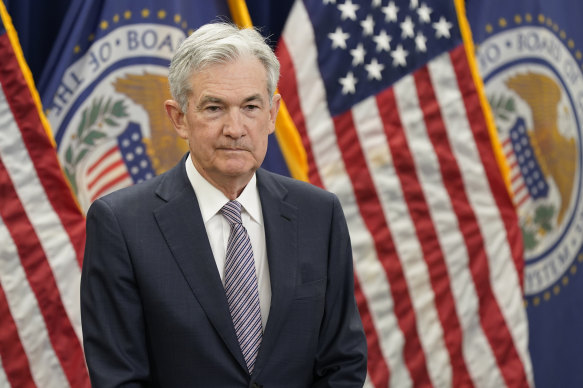Aging demographics in developed economies have seen a pandemic-accelerated shrinkage in the pools of available workers, with older workers retiring. In the US (but not Australia) the participation rates for older workers and women have fallen.
With inflation at near double-digit levels in the US (9.1 per cent), Europe (8.6 per cent and rising) and the UK (9.4 per cent) and tracking towards 8 per cent in Australia central bankers are trying to engineer a reduction in demand to bring it more into line with the reduced supply using the only tools available to them – raising interest rates and tightening credit conditions.

Jerome Powell’s US Fed and central banks around the world are desperately trying to rein in soaring inflation. Credit:AP
They are trying to burn off the excessive inflation even if they kill economic growth in the process.
When the latest US inflation data is released in the US this Wednesday it is likely to show some moderation in the US headline rate, driven by a recent sharp fall in oil prices.
The oil price, which was above $US120 a barrel only two months ago, is now down to about $US94 a barrel. That’s partly a rational demand-side response to the steep increases in fuel costs but also flows from the slowdown in global economic activity. Other key commodity prices – metals and agricultural – have also failed back after material spikes.
Core inflation in the US, which excludes fuel and food costs, is expected to remain elevated, however, and may even increase. It’s that rate, rather than the headlines rate, that guides central bank reactions.
loading
The International Monetary Fund last month cut its forecasts for global growth to 3.2 per cent. Last year the global economy grew 6.1 per cent. The war in Ukraine and China’s spluttering, COVID-affected economy, are the major contributors to the contraction in the growth rate.
Rapidly rising interest rates, and a tightening of credit conditions as the key central banks unwind quantitative easing programs that injected about $US12 trillion into the global financial system in response to the pandemic, will also impact growth and threaten the stability of some overly-indebted developing economies.
With the central bankers determined to bring inflation under control, interest rates in developed economies are going to rise a lot further – the US bond market is signaling a federal funds rate of somewhere between 3.5 per cent and 4 per cent by March next year against the current range of 2.25 per cent to 2.5 per cent –and do a lot more damage to economic growth rates.
The US yield curve is now as inverted as it has been in decades, with the difference between the yield on two-year notes (3.25 per cent) and 10-year bonds (2.83 per cent) now about 42 basis points. Investments of the curve – normally bond investors are compensated with higher yields for the risks of holding longer duration securities — have preceded every US recession since the 1970s.
Thus, however robust the underlying conditions in economies like the US or Australia’s, the central bankers are going to choke off any growth and force unemployment to rise to bring the supply-demand equation into a better balance.
It’s difficult to reconcile economies that are creating jobs faster than they can fill them and within which demand for travel, cars and goods is overwhelming supply, with data that suggests the economies are shrinking or slowing.
As renowned markets economist Mohamed El-Erian said to Bloomberg after Friday’s US jobs report, the Fed and its peers are going to have to “somehow break” their economies to bring inflation under control. Perhaps that’s a bit strong, but they are certainly going to have to risk policy over-kill and nasty recessions to tame their inflation rates.
“Soft landings” are the objective but they are difficult to engineer with the crude tools central bankers have at hand and in economic and geopolitical circumstances that are very different to those they’ve responded to in the past or which predated the pandemic.
Along with the increased geopolitical tensions, the decoupling of major economies and the redesign of global supply chains – the winding back of globalization – are the changes in China and an economy that powered much of the world’s growth in recent decades.
China’s population is ageing, its economy’s cost base has risen and its increasingly assertive geopolitics have generated heightened tensions in its relationships with the West.
loading
The post-pandemic global economy that eventually emerges will be different to the one that entered 2020, with the increased costs of the new supply chains and with less integration of economies and societies increasing input costs and prices and weighing heavily on growth even as governments that showered their economies with fiscal stimulus in response to the pandemic pursue contractionary policies to repair their finances.
This is a very significant, if rather strange, period in economic history.
